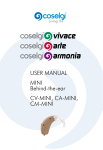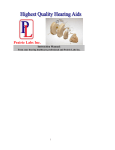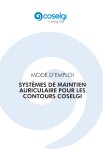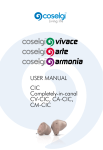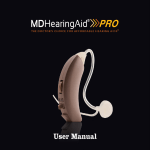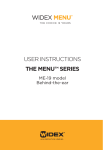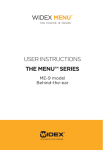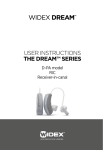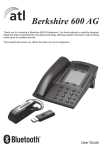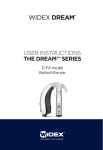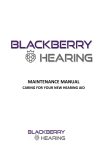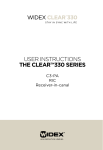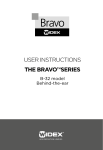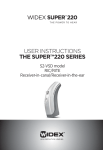Download USER MANUAL BTE Behind-the-ear CV-BTE, CA-BTE
Transcript
USER MANUAL BTE Behind-the-ear CV-BTE, CA-BTE, CM-BTE Your hearing aid (To be filled out by the hearing care professional) CV CA CM Date:_______________________________________ Battery size: 13 2 Contents symbols . . . . . . . . . . . . . . . . . . . . . . . . . . . . . . . . . 4 Description of the hearing aid . . . . . . . . . . . . . 5 The battery . . . . . . . . . . . . . . . . . . . . . . . . . . . . . . . . 8 Inserting the battery . . . . . . . . . . . . . . . . . . . . . . . . 8 Low battery indication . . . . . . . . . . . . . . . . . . . . . 10 Turning the hearing aid on and off . . . . . . . . . . . . . 11 Function signals . . . . . . . . . . . . . . . . . . . . . . . . . . . 12 Right/left identification . . . . . . . . . . . . . . . . . . . . . . 13 Positioning the hearing aid . . . . . . . . . . . . . . . . . . . 14 Removing the hearing aid . . . . . . . . . . . . . . . . . . . 15 Automatic volume adjustment . . . . . . . . . . . . . . . . . 16 Manual volume adjustment . . . . . . . . . . . . . . . . . . . 16 Listening programs . . . . . . . . . . . . . . . . . . . . . . . . . 18 Switching between the listening programs . . . . . . . 19 Using a telephone . . . . . . . . . . . . . . . . . . . . . . . . . 20 Cleaning . . . . . . . . . . . . . . . . . . . . . . . . . . . . . . . 21 The hearing aid . . . . . . . . . . . . . . . . . . . . . . . . . . . In case of malfunction . . . . . . . . . . . . . . . . . . Accessories . . . . . . . . . . . . . . . . . . . . . . . . . . . . . Caring for your hearing aid . . . . . . . . . . . . . Warnings . . . . . . . . . . . . . . . . . . . . . . . . . . . . . . Advice . . . . . . . . . . . . . . . . . . . . . . . . . . . . . . . . . . REGULATORY INFORMATION . . . . . . . . . . . . . . . . . PROGRAM FORMS . . . . . . . . . . . . . . . . . . . . . . . . . 3 22 23 24 26 27 30 31 34 symbols The following symbols will be used throughout the manual: WARNING Messages with this heading indicate serious adverse reactions, potential safety hazards and inadequate performance of device. CAUTION Messages with this heading indicate/include information regarding any special care to be exercised. Not for general waste. 4 Description of the hearing aid 1.Microphone openings 2.Volume control (optional) 3.Program button 4.On/off switch 5.Battery drawer with nail grip 1 2 3 4 5 Your hearing aid is used with an ear-set which consists of a tube and an open dome, ear-tip or earmold. The illustration above shows the hearing aid without the ear-set. The choice of ear-set solution depends on your specific needs. Please refer to the separate earset user manual. 5 NOTE In addition to these user instructions, a separate user manual is provided describing the various ear-set solutions available for your hearing aid: “Ear-sets for Coselgi BTE hearing aids”. WARNING This booklet and the manual “Ear-sets for Coselgi BTE hearing aids” contain important information and instructions. Read these booklets carefully before you start using the hearing aid. NOTE Your hearing aid, ear-set and accessories may not look exactly as illustrated in this booklet. We also reserve the right to make any changes considered necessary. 6 Intended use The hearing aids are intended as air conduction amplification devices to be used in everyday listening environments. Indications for use The devices are indicated for individuals with a range of hearing loss severity from minimal (10 dB HL) to severe (85 dB HL) and all hearing loss configurations. They are to be programmed by licensed hearing care professionals (audiologists, hearing aid specialists, otolaryngologists) who are trained in hearing (re)habilitation. 7 The battery We recommend zinc-air batteries. Use a size 13 battery for the hearing aid. To obtain replacement batteries, please consult your hearing care professional. It is important to take note of the expiration date and the recommendations on the battery pack regarding disposal of used batteries. Otherwise there is a risk that the battery life may be reduced. Inserting the battery Before inserting a new battery into the hearing aid, remember to remove the adhesive tab. Once the tab has been removed, wait 60 seconds before placing the battery into the hearing aid. CAUTION Do not use batteries if there is a sticky residue from the tab or other unwanted substance, as this can cause the hearing aid to malfunction. 8 Use the nail grip to gently swing the battery drawer open. Place the battery in the drawer, so that the plus (+) sign on the battery faces upward. You can use the battery magnet provided to steer the battery into place. + If the battery drawer does not close easily, the battery is incorrectly inserted. When changing battery, it is a good idea to hold the hearing aid over a table. 9 Low battery indication Four rapid beep-tones will sound when the battery is nearly exhausted, unless this function has been disabled. We recommend that you always have a spare battery with you. For adjustment of the beep-tone level or disabling of the function, please consult your hearing care professional. WARNING Never leave an exhausted battery in the hearing aid. Exhausted batteries may leak, damaging the hearing aid. WARNING Your hearing aid may stop functioning, for instance if the battery is exhausted. You should be aware of this possibility, in particular when you are in traffic or are otherwise dependent on warning signals. 10 Turning the hearing aid on and off The battery drawer of the hearing aid also functions as the on/off switch. Push the switch upwards to turn on the hearing aid. Push the switch downwards to turn off the hearing aid. The word “OFF” is clearly visible on the switch when the hearing aid is turned off. Please remember to turn off the hearing aid when it is not in use. Remove the battery if the hearing aid will not be used for several days. 11 Function signals Your hearing aid may be set to produce a signal to indicate the use of certain functions. The signal is tones adjusted by the hearing care professional in consultation with you. The signal can also be deactiviated. 12 Right/left identification If you wear hearing aids on both ears, the hearing aids can be provided with colored marks (red mark = right and blue mark = left). The arrow shows the position of the identification mark. 13 Positioning the hearing aid Insert the earpiece in the ear canal while holding the lower part of the tube. It may help to pull the outer ear backwards and upwards with the opposite hand. Place the hearing aid behind the ear, so that the hearing aid and tube rest comfortably on the ear, close to your head. The illustrations show an open dome. For further information on dome/ear-tip/earmold types, anchors and procedures, see the separate ear-set user manual provided. 14 Removing the hearing aid Remove the hearing aid from its position behind the ear. Carefully pull the earpiece out of the ear canal, while holding the lower part of the tube. If the earpiece is provided with an extraction cord, take hold of this and carefully pull the earpiece out of the ear canal. 15 Automatic volume adjustment The hearing aid volume is adjusted automatically in accordance with your sound environment. Manual volume adjustment Your hearing aid may furthermore be provided with a volume control, shaped like a small lever. Push the lever upward to gradually raise the volume. Push the lever downwards to gradually lower the volume. Each time you operate the volume control, you will hear a beep-tone unless this function has been disabled. When the maximum or minimum adjustment level is reached, a steady tone will sound. CAUTION If the volume in the hearing aid is generally too loud or too weak, or the reproduced sounds are distorted, or if you would like any further information, consult your hearing care professional. 16 To turn off the sound completely •Keep pressing the volume control lever downwards after the steady tone has sounded To turn the sound on again •Press the lever upwards or •Change listening program If you wish to have beep-tone level adjusted or the volume control disabled, please consult your hearing care professional. 17 Listening programs Depending on how your hearing care professional has programmed your hearing aid, you can have several listening programs intended for specific listening situations. At the back of this booklet your hearing care professional can list the listening programs that are available in your hearing aid. If your needs change over time, the combination of listening programs can be changed. Main program: Standard program. New user program: Has the same features as the Main program, but provides slightly less amplification. Phone: For talking on the phone. TV: For listening to the TV. T: In this program you listen via the telecoil (T) and not via the hearing aid microphone (M). The telecoil is used where a loop system is installed. Activating the telecoil program allows you to listen to a specific sound source and shut out surrounding sounds. MT: In this program you listen via the hearing aid microphone (M) and the telecoil (T). 18 Switching between the listening programs To change programs, press the program button briefly. Each time you switch to another program, an acoustic indicator will sound unless this function has been disabled. Program Program Program Program 1: One short beep 2: Two short beeps 3: Three short beeps 4: One long and one short beep If you wish to have the program button disabled, please consult your hearing care professional. 19 Using a telephone When using a telephone, we recommend that you hold the telephone against your head at an angle above your ear, rather than directly against the ear. If the sound is not optimal, try moving the telephone earpiece to a slightly different position. 20 Cleaning The following cleaning accessories are available for the hearing aid and ear-set*. For cleaning the ear-set, see the user manual “Ear-sets for Coselgi BTE hearing aids”. 1. Cloth 2. Wax removing tool 3. Cleaning thread Contact your hearing care professional if you need additional supplies of cleaning accessories. * Selection depends on ear-set type. 21 The hearing aid Clean the hearing aid with the soft cloth after use. WARNING Never use water or cleaning solutions to clean the hearing aid, as this may cause it to malfunction. When the hearing aid is not in use, the battery drawer should be left open, to ventilate the hearing aid and allow it to dry. + 22 In case of malfunction Problem Possible cause Solution The hearing aid is completely silent The hearing aid is not turned on Make sure the battery drawer is pushed all the way upwards The battery does not Insert a new battery in work the hearing aid The hearing aid volume is not powerful enough Your ear is blocked by earwax Contact your ENT doctor/physician Your hearing may have changed Contact your hearing care professional The hearing aid whistles continuously Your ear is blocked by earwax Contact your ENT doctor/physician The hearing aid functions intermit tently The on/off switch is dirty Push the switch back and forth a couple of times Note: This information covers only the hearing aid. See the “Ear-sets for Coselgi BTE hearing aids” user manual for information specific to your ear-set. If the problems persist, contact your hearing care professional for assistance. 23 Accessories Audio input The hearing aid can be furnished with an audio shoe. This allows direct connection to different kinds of accessories (FM and CROS/Bi-CROS systems), as well as external audio equipment (radio, TV, etc.). On the form below, your hearing care professional can make a note of the audio programs you have access to and where they are located. For more information on the use of audio input consult your hearing care professional. Program order DAI M-DAI 1 2 3 4 24 WARNING If the hearing aid is connected to equipment which is connected to the electrical mains, this equipment must comply with IEC 60065, IEC 60950-1, IEC 60601-1 or equivalent UL safety standards. Do not connect the hearing aid to sockets that are labelled with one or more of the following symbols: FM systems A FM system is an assistive listening device that can be used as an accessory for the hearing aid. The FM system makes it easier to understand speech in difficult listening situations. For help to determine whether you could benefit from a FM system, please consult your hearing care professional. 25 Caring for your hearing aid The hearing aid is a valuable object and should be treated with care. Here are some things you can do to prolong the life of your hearing aid: CAUTION •Turn off your hearing aid when it is not in use. Remove the battery if the hearing aid will not be used for several days. •When the hearing aid is not in use, keep it in its case in a cool, dry location out of reach of children and pets. •Do not expose the hearing aid to extreme temperatures or high humidity. Make sure to dry the hearing aid thoroughly after heavy perspiration such as that which may occur during intense physical activity, e.g. playing sports. •Avoid dropping your hearing aid – perform cleaning and battery changes while holding the hearing aid above a soft surface. •Do not wear your hearing aid while in the shower or swimming, or when using a hair dryer, perfume, hair and body sprays or gels such as suntanning lotions or creams. •In environments with high humidity, a drying kit may be used daily to reduce the amount of moisture inside the hearing aid. See the instructions enclosed with the drying kit. 26 Warnings WARNING Hearing aids and batteries can be dangerous if swallowed or used improperly. Swallowing or improper use can result in s evere injury or even fatalities. In case of ingestion, contact a physician immediately and the 24 Hour National Button Battery Ingestion Hotline at (202) 625-3333. •Keep hearing aids and their parts, accessories and batteries out of reach of children and anyone else who might swallow such items or otherwise cause injury to themselves. Do not change batteries in front of them and do not let them see where you keep your battery supply. Discard used batteries carefully. •Batteries are very small and can easily be mistaken for pills or the like. Never put a battery or hearing aid in your mouth for any reason as you may risk swallowing it. 27 warning •Risk of explosion if battery is replaced by an incorrect type or recharged. Dispose of used batteries according to the instructions. •Never allow others to wear your hearing aid, as this could cause permanent damage to their hearing. •When selecting a listening program, please remember that there are situations in which it is particularly important to be able to hear the surrounding sounds (e.g. traffic, warning signals). •The hearing aid is made of modern non-allergenic materials. Nonetheless, in rare cases skin irritation may occur. If you notice skin irritation in or around your ear or ear canal, contact your hearing care professional. 28 warning •Be aware that the use of any type of hearing aid may involve a slightly increased risk of infection in the ear canal. An infection can arise as a result of inadequate ventilation of the ear. We therefore recommend that you remove the hearing aid and ear-set from your ear at night to allow the ear canal to be ventilated. Make sure that you clean and inspect your hearing aid and ear-set as required. If an infection occurs, you should seek medical attention and contact your hearing care professional for advice on how to disinfect the various hearing aid parts. Do not under any circumstances use alcohol, chlorine or similar substances. •Do not use Coselgi hearing aids in mines or other areas with explosive gases. •Do not wear your hearing aid during radiation, X-rays, MRIs, CT or other medical treatments and scans. The emissions from these procedures as well as from other types of radiation, such as that in a microwave oven, can damage your hearing aid. Radiation from, for example, room surveillance equipment, burglar alarms and cell phones is weaker and will not damage the hearing aid, but may create audible interference. CAUTION •Although your hearing aid has been designed to comply with the most stringent international electromagnetic compatibility standards, the possibility cannot be excluded that it may cause interference with other equipment, such as medical devices. •Never try to open or repair the hearing aid yourself. 29 Advice NOTE •The hearing aid will not restore normal hearing and will not prevent or improve a hearing loss resulting from organic conditions. However, the hearing aid can help you to make the best possible use of your remaining hearing ability. You should also bear in mind that it can take time to get used to a new hearing aid and new sounds. •In most cases, using the hearing aid infrequently will not permit you to gain full benefit from it. •The use of a hearing aid is only part of hearing habilitation and may need to be supplemented by auditory training and instruction in lipreading. •The use of hearing aids increases the risk of accumulation of earwax. Contact your physician/ENT doctor if you suspect that a plug of earwax has accumulated in your ear. Earwax may not only reduce your own hearing but also the effect of the hearing aid considerably. It is a good idea to ask your physician to clean your ears a couple of times a year. 30 REGULATORY INFORMATION Contraindications: •Congenital or traumatic deformity of the ear •Active drainage from the ear within 90 days •History of rapid progressive hearing loss within previous 90 days •Acute or chronic dizziness •Sudden unilateral hearing loss in previous 90 days Important notice for prospective hearing aid users Good health practice requires that a person with a hearing loss have a medical evaluation by a licensed physician (preferably a physician who specializes in diseases of the ear) before purchasing a hearing aid. Licensed physicians who specialize in diseases of the ear are often referred to as otolaryngologists, otologists, or otorhinolaryngologists. The purpose of medical evaluation is to assure that all medically treatable conditions that may affect hearing are identified and treated before the hearing aid is purchased. Following the medical evaluation, the physician will give you a written statement that states that your hearing loss has been medically evaluated and that you may be considered a candidate for a hearing aid. The physician will refer you to an audiologist or a hearing aid dispenser, as appropriate, for a hearing aid evaluation. The audiologist or hearing aid dispenser will conduct a hearing aid evaluation to assess your ability to hear with and without a hearing aid. The hearing aid evaluation will enable the audiologist or dispenser to select and fit a hearing aid to your individual needs. If you have reservations about your ability to adapt to amplification, you should inquire about the availability of a trial-rental or purchase-option program. Many hearing aid dispensers now offer programs that permit you to wear a hearing aid for a period of 31 time for a nominal fee after which you may decide if you want to purchase the hearing aid. Federal law restricts the sale of hearing aids to those individuals who have obtained a medical evaluation from a licensed physician. Federal law permits a fully informed adult to sign a waiver statement declining the medical evaluation for religious or personal beliefs that preclude consultation with a physician. The exercise of such a waiver is not in your best health interest and its use is strongly discouraged. Children with hearing loss In addition to seeing a physician for a medical evaluation, a child with a hearing loss should be directed to an audiologist for evaluation and rehabilitation since hearing loss may cause problems in language development and the educational and social growth of a child. An audiologist is qualified by training and experience to assist in the evaluation and rehabilitation of a child with a hearing loss. 32 Hearing aids, accessories and batteries should not be disposed of with normal household waste. Please consult your national Coselgi distributor for advice on how to dispose of these items. 33 PROGRAM FORMS Programs available in your hearing aid: Program Chosen position Main program New user program Phone TV T MT 34 Programs available in your hearing aid: Program Chosen position Main program New user program Phone TV T MT 35 Manufacturer ¡9 514 0135 041>¤ ¡#01v¤ Printed by HTO / 2013-09 9 514 0137 041 #02




































